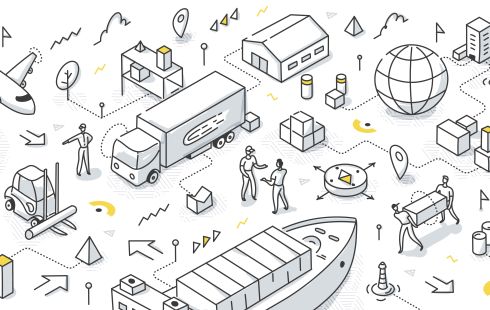18 Logistics Companies Getting Packages to Our Doorsteps

Logistics refers to the strategic movement of goods and services from one place to another. The term was originally used to describe the transportation of military supplies to soldiers on the front line, but with the rise of e-commerce and online shopping, logistics is now integral to the global supply chain process, and it encompasses the procurement, storage and distribution of materials that power the economy.
Logistics is the process of coordinating how goods and products are obtained, stored and distributed. Manufacturers rely on logistics while overseeing complex operations in order to maintain efficiency, reduce costs and ensure that consumers’ needs are met.
Due to the prominence of e-commerce companies, like Amazon, logistics embodies more than the actual movement of products from one place to another.
An important part of logistics is the steps taken in order to maximize customer satisfaction. This includes elements such as demand planning, order fulfillment, inventory management and customer service operations. These elements ensure that the goods consumers need are stocked and orders are fulfilled in a timely manner.
Logistics management software has aided the expansion of what the logistics industry entails and how goods are brought to consumers. Some examples of software for the logistics industry include transportation management systems, enterprise resource planning software, yard management systems and warehouse management systems. The growth of this technology has created a need for specialized roles and companies focused on building and implementing logistics software.
As technology continues to transform our world, its influence on the logistics industry will only become greater, prompting a shift in how companies quickly and efficiently deliver their products to consumers.
Supply chain management and logistics are often thought of as one in the same, but the terms actually capture two distinct parts of what it means to move resources.
Supply chain management is the larger network that connects global vendors, transportation companies, distributors and warehouses. This network functions as the framework that logistics works under.
Logistics is the process companies undertake to deliver goods to consumers. This process involves purchasing and delivering materials, packaging and shipping goods as well as transporting goods and products to distributors.
Logistics may not be the first thing that comes to mind when a purchase is made online or in a brick-and-mortar store, but it is undeniably intertwined with everything we buy. Logistical considerations affect global supply chains, what items are in stock and when as well as where manufacturers chose to build their facilities. These influences are just one way that logistics displays importance in our global economy.
Utilizing logistics properly is essential to the function of businesses across the globe — and effectively managed logistics typically leads to positive business outcomes. With the growing complexity of the global supply chain, properly implemented and managed logistics are more important than ever.
The importance of logistics also stretches to simplifying communication and reducing costs. Effective logistics help foster relationships between suppliers, shipping services and warehousers through automated systems. The connectivity of logistics improves delivery and fulfillment of orders, which in turn reduces overhead costs. Costs are also reduced by the ability to use logistical systems to purchase goods based on supply forecasts and improved inventory management.
The logistics industry has transformed over the past century. During the 1960s, the supply chain was indelibly changed when IBM developed the world’s first computerized inventory management and forecasting system, which made it simpler to track orders, inventory and distribution. Since then, the industry has been propelled even further into the future, bringing with it an entirely new perspective on how we exchange goods across the globe.
Today, the logistics realm is heavily influenced by AI and machine learning, which many logistics companies use to offer more accurate forecasting and enhanced order management. With these technological advances and more, the supply chain has been given the chance to prosper worldwide.
Given the rise of e-commerce and the rapid growth of the online ordering space, logistics has become one of the world’s fastest-growing industries. Many organizations have emerged in response to logistics’ continuous transformation, dedicated to optimizing the supply chain in unimaginable ways. Perhaps the most well-known logistics leader to have emerged over the past few decades is e-commerce giant Amazon. While Amazon was initially founded as an online marketplace for books, the company has become a household name across the globe, altering the way in which products are transported and delivered to consumers.
Amazon has become famous for its logistics strategy, which is made possible by the company’s global network of distribution, sortation and fulfillment centers. Amazon’s same-day and next-day delivery model rests on a complex logistics framework. Products are delivered to the company’s fulfillment centers before being moved to sortation centers. Once goods have made it through Amazon’s sortation centers, they are loaded onto a wide range of transportation modes, which can include the company’s own fleet of delivery trucks and airplanes.
Amazon has entirely redefined the logistics landscape, yet it’s not the only major third party logistics (3PL) provider making waves. Companies like UPS and FedEx have played a significant role in the transformation of logistics. These companies are capable of transporting goods from their point of origin, warehousing products and packaging them. Working with 3PL providers offers numerous advantages for both small and large businesses including the ability to obtain better rates, easily expand into new markets and improve customer service.
While 3PL providers are capable of handling the entirety of a company’s supply chain operations, the different components of the logistics process can be carried out by individual players. For instance, freight companies solely handle the physical transportation of goods, while freight forwarders are dedicated to optimizing transport solutions and handling necessary documentation. In this sense, logistics could be seen as a complex web of moving parts, which operate in tandem with one another in order to boost efficiency and reduce costs within the supply chain.
By way of example, Flexport has developed an operating model designed to simplify global freight forwarding, while Transfix has created a marketplace that connects shippers with a national network of carriers.
Given the logistics industry’s seemingly endless transformation, logistics management is naturally made up of many different elements. These components include the planning, procurement and coordination of manufacturing materials, strategizing the development of a product and reclaiming materials and supplies involved in the manufacturing of a product. For logistics managers, keeping track of the many different aspects of a supply chain can be nearly impossible. Luckily, logistics tech has successfully reshaped the industry, turning it into a robust sector fueled by the rise of innovative new technologies.
As the demand for online delivery grows and consumers’ expectations become larger, the need to optimize logistics has never been greater. As a result, software developers have set to work creating platforms designed to make the supply chain more manageable. Real-time visibility software providers such as FourKites, project44 and FreightVerify empower supply chain operators to simply identify issues and quickly resolve them, saving organizations huge amounts of time during which they can focus on other aspects of the logistics process. Likewise, fleet management company Motive has made it easier to track cargo and drivers while improving efficiency and safety along the supply chain.
Considering all of the work that goes into Amazon’s e-commerce services, it may come as no surprise that the company relies heavily on the latest technology in order to accomplish its consumer delivery goals. Amazon has been using AI to power its product recommendations for years. The company has also adopted machine learning to build the handheld virtual assistant, Amazon Echo.
Amazon doesn’t solely use technology to maximize the customer experience. In fact, the company’s technological expertise extends to its packaging and delivery services. The e-commerce company made headlines in 2012 when it introduced automation into its supply chain upon acquiring Kiva Systems. Today, Amazon’s warehouses are filled with thousands of robots built to optimize the picking and packing process.
Amazon isn’t the only logistics leader that has unlocked the potential of robotics. In fact, the warehouse automation space has grown tremendously over the past several years and is expected to become increasingly more valuable over time. The growth of this sector is attributed largely to the steady rise of e-commerce, which has ignited the need to send products out quickly while lowering operating costs. The popularity of online grocery shopping in particular has bolstered the growth of warehouse automation, as online grocery retailers have been forced to meet consumers’ ever-increasing demands while competing with brick-and-mortar stores.
As warehouse automation continues to infiltrate the logistics industry, autonomous vehicles are becoming a supply chain essential. For companies like Amazon, self-driving vehicles are not only profitable within the warehouse, as they harbor the potential to make on-road delivery faster and more efficient. Companies like Starship Technologies are developing revolutionary new ways to autonomously transport goods, thus unleashing new possibilities within the logistics realm.
Alongside the emergence of autonomous vehicles, the commercial use of drones has opened up new avenues for supply chain management. Within a warehouse setting, drones can be used for aerial inspection and can even carry out maintenance requests, all of which can save manufacturers vast amounts of time.
Given drones’ ability to quickly transport small items, many tech companies are trying their hand at developing aerial transportation modes. For instance, logistics startup Zipline has created unmanned drones designed to quickly deliver goods, reduce emissions and integrate with existing operations.
While there are many options when it comes to packaging and delivering goods quickly, supply chain experts are still searching for ways to manufacture products at a speed that meet consumers’ growing expectations. For this reason, 3D printing has entered the logistics space as a possible solution. The process of gathering supplies and producing a product often requires the most time and effort within the supply chain setting.
If 3D printing were applied to the production process, consumers would have greater control over the supply chain. Potentially, a consumer could place an order for a product and then a local 3D printer shop would quickly create the product before sending it out for delivery. 3D printing could ultimately disrupt the logistics industry, as it offers manufacturers the opportunity to produce complex and customized goods faster than ever before.

